display SKODA FABIA 2004 1.G / 6Y Owner's Guide
[x] Cancel search | Manufacturer: SKODA, Model Year: 2004, Model line: FABIA, Model: SKODA FABIA 2004 1.G / 6YPages: 247
Page 35 of 247
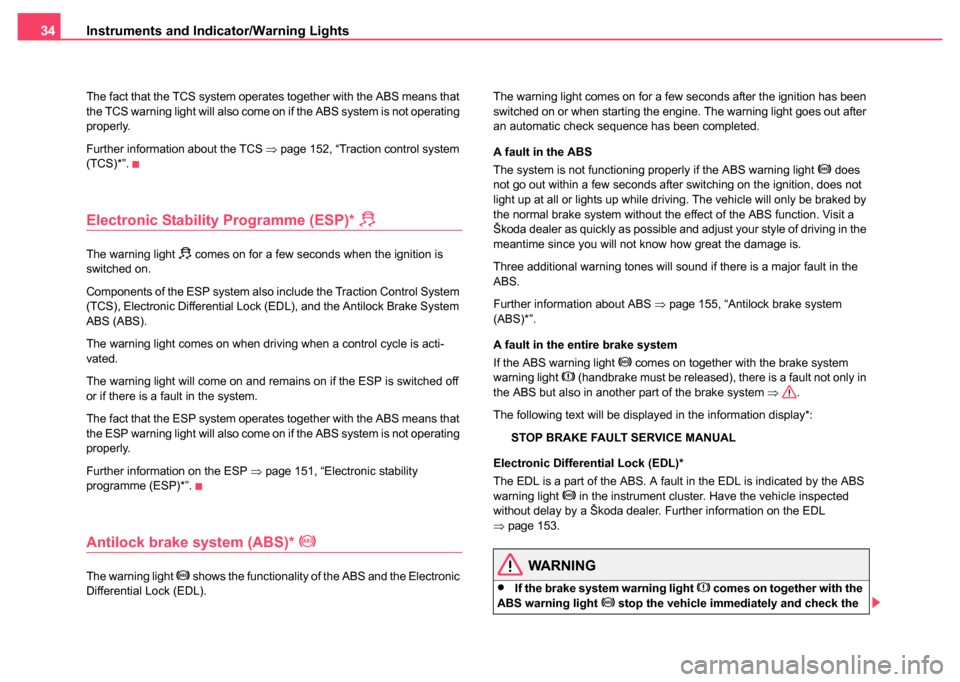
Instruments and Indicator/Warning Lights
34
The fact that the TCS system operates together with the ABS means that
the TCS warning light will also come on if the ABS system is not operating
properly.
Further information about the TCS ⇒page 152, “Traction control system
(TCS)*”.
Electronic Stability Programme (ESP)*
The warning light comes on for a few seconds when the ignition is
switched on.
Components of the ESP system also include the Traction Control System
(TCS), Electronic Differential Lock (EDL), and the Antilock Brake System
ABS (ABS).
The warning light comes on when driving when a control cycle is acti-
vated.
The warning lig ht will come on an d remains on if the ESP is switched off
or if there is a fault in the system.
The fact that the ESP system operates together with the ABS means that
the ESP warning light will also come on if the ABS system is not operating
properly.
Further information on the ESP ⇒page 151, “Electronic stability
programme (ESP)*”.
Antilock brake system (ABS)*
The warning light shows the functionality of the ABS and the Electronic
Differential Lock (EDL). The warning light comes on for a few seconds after the ignition has been
switched on or when starting the engine. The warning light goes out after
an automatic check sequence has been completed.
A fault in the ABS
The system is not functioning properly if the ABS warning light
does
not go out within a few seconds after switching on the ignition, does not
light up at all or lights up while driving. The vehicle will only be braked by
the normal brake system without the effect of the ABS function. Visit a
Škoda dealer as quickly as possible and adjust your style of driving in the
meantime since you will not know how great the damage is.
Three additional warning tones will sound if there is a major fault in the
ABS.
Further information about ABS ⇒page 155, “Antilock brake system
(ABS)*”.
A fault in the entire brake system
If the ABS warning light
comes on together with the brake system
warning light (handbrake must be released), there is a fault not only in
the ABS but also in another part of the brake system ⇒.
The following text will be displayed in the information display*: STOP BRAKE FAULT SERVICE MANUAL
Electronic Differential Lock (EDL)*
The EDL is a part of the ABS. A fault in the EDL is indicated by the ABS
warning light
in the instrument cluster. Have the vehicle inspected
without delay by a Škoda dealer. Further information on the EDL
⇒ page 153.
WARNING
•If the brake system warning light comes on together with the
ABS warning light stop the vehicle immediately and check the
Page 36 of 247
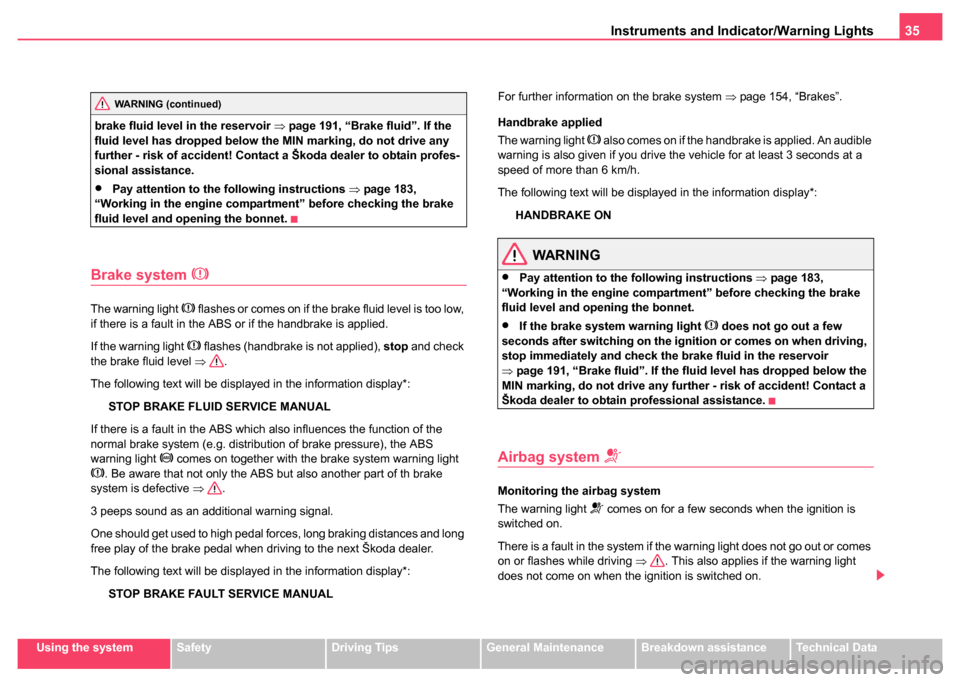
Instruments and Indicator/Warning Lights35
Using the systemSafetyDriving TipsGeneral MaintenanceBreakdown assistanceTechnical Data
brake fluid level in the reservoir
⇒page 191, “Brake fluid”. If the
fluid level has dropped below th e MIN marking, do not drive any
further - risk of accident! Contact a Škoda dealer to obtain profes-
sional assistance.
•Pay attention to the following instructions ⇒page 183,
“Working in the engine compartment” before checking the brake
fluid level and opening the bonnet.
Brake system
The warning light flashes or comes on if the brake fluid level is too low,
if there is a fault in the ABS or if the handbrake is applied.
If the warning light
flashes (handbrake is not applied), stop and check
the brake fluid level ⇒.
The following text will be displayed in the information display*:
STOP BRAKE FLUID SERVICE MANUAL
If there is a fault in the ABS which also influences the function of the
normal brake system (e.g. distribution of brake pressure), the ABS
warning light
comes on together with the brake system warning light . Be aware that not only the ABS but also another part of th brake
system is defective ⇒.
3 peeps sound as an additional warning signal.
One should get used to high pedal forces, long braking distances and long
free play of the brake pedal when driving to the next Škoda dealer.
The following text will be displayed in the information display*: STOP BRAKE FAULT SERVICE MANUAL For further information on the brake system
⇒page 154, “Brakes”.
Handbrake applied
The warning light
also comes on if the handbrake is applied. An audible
warning is also given if you drive the vehicle for at least 3 seconds at a
speed of more than 6 km/h.
The following text will be displayed in the information display*:
HANDBRAKE ON
WARNING
•Pay attention to the following instructions ⇒page 183,
“Working in the engine compartment” before checking the brake
fluid level and opening the bonnet.
•If the brake system warning light does not go out a few
seconds after switching on the ignition or comes on when driving,
stop immediately and check the brake fluid in the reservoir
⇒ page 191, “Brake fluid”. If the fluid level has dropped below the
MIN marking, do not drive any further - risk of accident! Contact a
Škoda dealer to obtain professional assistance.
Airbag system
Monitoring the airbag system
The warning light
comes on for a few seconds when the ignition is
switched on.
There is a fault in the system if the warning light does not go out or comes
on or flashes while driving ⇒. This also applies if the warning light
does not come on when the ignition is switched on.
WARNING (continued)
Page 37 of 247
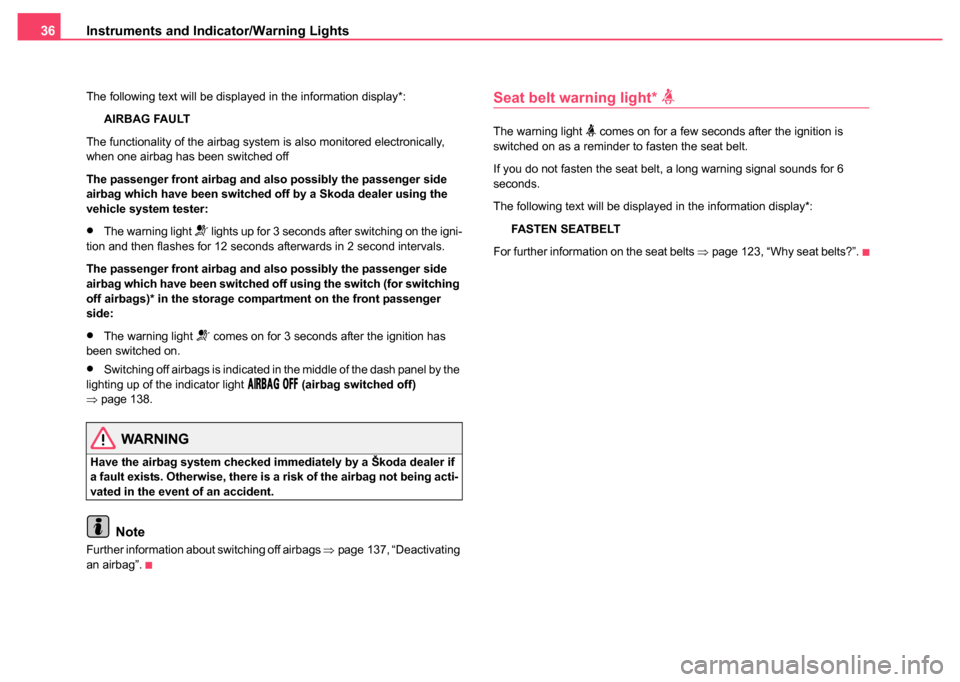
Instruments and Indicator/Warning Lights
36
The following text will be displayed in the information display*:
AIRBAG FAULT
The functionality of the airbag system is also monitored electronically,
when one airbag has been switched off
The passenger front airbag and also possibly the passenger side
airbag which have been switched off by a Skoda dealer using the
vehicle system tester:
•The warning light lights up for 3 seconds after switching on the igni-
tion and then flashes for 12 seconds afterwards in 2 second intervals.
The passenger front airbag and also possibly the passenger side
airbag which have been switched off using the switch (for switching
off airbags)* in the storage compartment on the front passenger
side:
•The warning light comes on for 3 seconds after the ignition has
been switched on.
•Switching off airbags is indicated in the middle of the dash panel by the
lighting up of the indicator light (airbag switched off)
⇒ page 138.
WARNING
Have the airbag system checked immediately by a Škoda dealer if
a fault exists. Otherwise, there is a risk of the airbag not being acti-
vated in the event of an accident.
Note
Further information about switching off airbags ⇒page 137, “Deactivating
an airbag”.
Seat belt warning light*
The warning light comes on for a few seconds after the ignition is
switched on as a reminder to fasten the seat belt.
If you do not fasten the seat belt, a long warning signal sounds for 6
seconds.
The following text will be displayed in the information display*:
FASTEN SEATBELT
For further information on the seat belts ⇒page 123, “Why seat belts?”.
Page 106 of 247
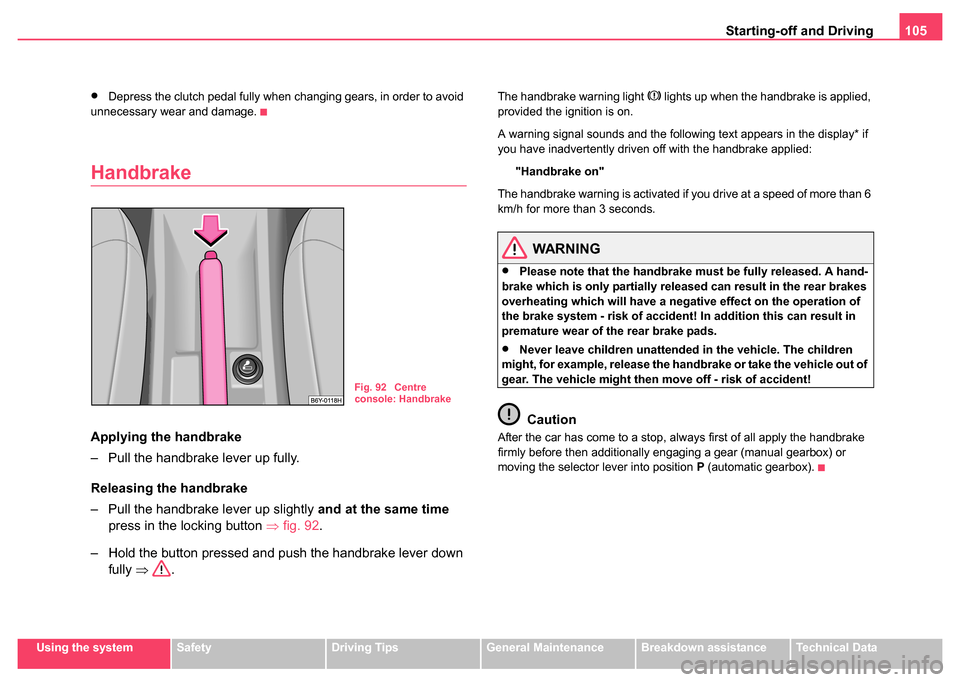
Starting-off and Driving105
Using the systemSafetyDriving TipsGeneral MaintenanceBreakdown assistanceTechnical Data
•Depress the clutch pedal fully when changing gears, in order to avoid
unnecessary wear and damage.
Handbrake
Applying the handbrake
– Pull the handbrake lever up fully.
Releasing the handbrake
– Pull the handbrake lever up slightly and at the same time
press in the locking button ⇒fig. 92 .
– Hold the button pressed and push the handbrake lever down fully ⇒ .
The handbrake warning light lights up when the handbrake is applied,
provided the ignition is on.
A warning signal sounds and the following text appears in the display* if
you have inadvertently driven off with the handbrake applied:
"Handbrake on"
The handbrake warning is activated if you drive at a speed of more than 6
km/h for more than 3 seconds.
WARNING
•Please note that the handbrake must be fully released. A hand-
brake which is only partially released can result in the rear brakes
overheating which will have a nega tive effect on the operation of
the brake system - risk of accident! In addition this can result in
premature wear of the rear brake pads.
•Never leave children unattended in the vehicle. The children
might, for example, release the handbrake or take the vehicle out of
gear. The vehicle might then move off - risk of accident!
Caution
After the car has come to a stop, always first of all apply the handbrake
firmly before then additionally engaging a gear (manual gearbox) or
moving the selector lever into position P (automatic gearbox).
Fig. 92 Centre
console: Handbrake
Page 112 of 247
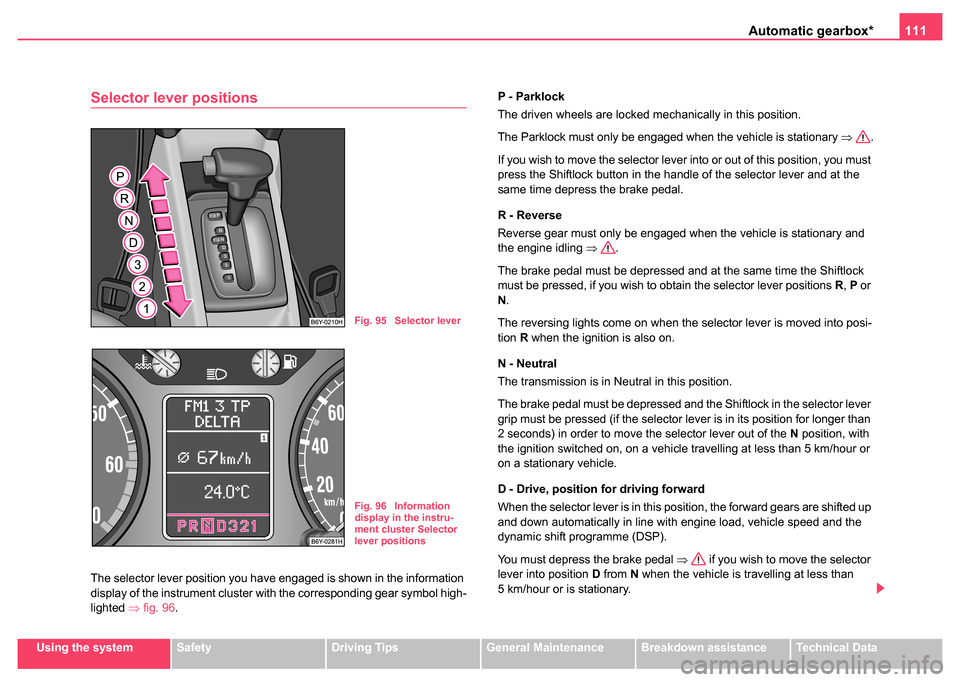
Automatic gearbox*111
Using the systemSafetyDriving TipsGeneral MaintenanceBreakdown assistanceTechnical Data
Selector lever positions
The selector lever position you have engaged is shown in the information
display of the instrument cluster with the corresponding gear symbol high-
lighted ⇒fig. 96. P - Parklock
The driven wheels are locked mechanically in this position.
The Parklock must only be engaged when the vehicle is stationary
⇒.
If you wish to move the selector lever into or out of this position, you must
press the Shiftlock button in the handle of the selector lever and at the
same time depress the brake pedal.
R - Reverse
Reverse gear must only be engaged when the vehicle is stationary and
the engine idling ⇒.
The brake pedal must be depressed and at the same time the Shiftlock
must be pressed, if you wish to obtain the selector lever positions R, P or
N .
The reversing lights come on when the selector lever is moved into posi-
tion R when the ignition is also on.
N - Neutral
The transmission is in Neutral in this position.
The brake pedal must be depressed and the Shiftlock in the selector lever
grip must be pressed (if the selector lever is in its position for longer than
2 seconds) in order to move the selector lever out of the N position, with
the ignition switched on, on a vehicle travelling at less than 5 km/hour or
on a stationary vehicle.
D - Drive, position for driving forward
When the selector lever is in this position, the forward gears are shifted up
and down automatically in line with engine load, vehicle speed and the
dynamic shift programme (DSP).
You must depress the brake pedal ⇒ if you wish to move the selector
lever into position D from N when the vehicle is travelling at less than
5 km/hour or is stationary.
Fig. 95 Selector lever
Fig. 96 Information
display in the instru-
ment cluster Selector
lever positions
Page 114 of 247
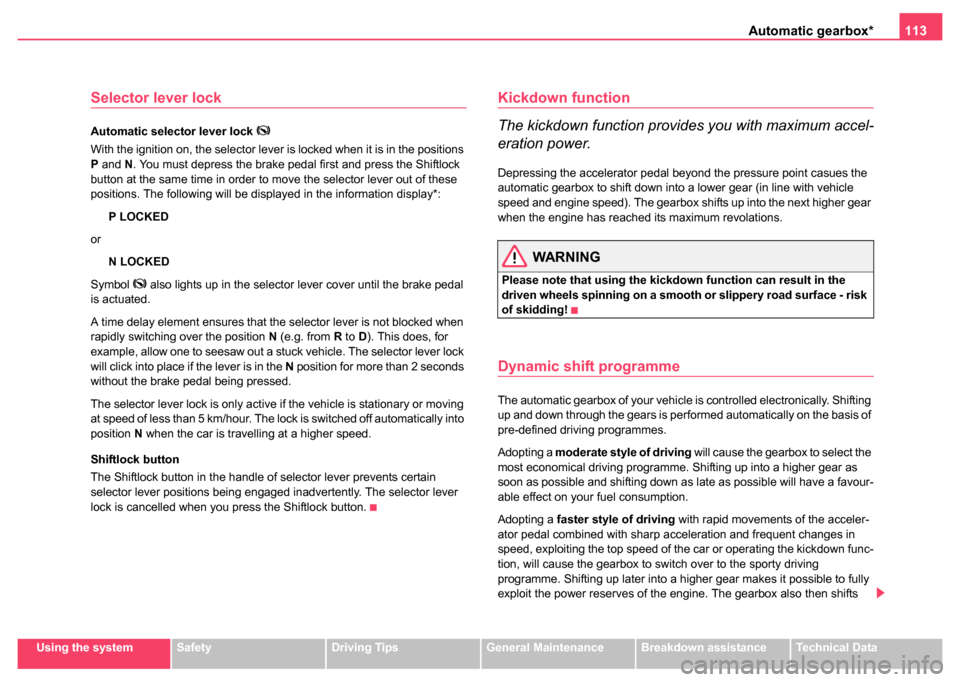
Automatic gearbox*113
Using the systemSafetyDriving TipsGeneral MaintenanceBreakdown assistanceTechnical Data
Selector lever lock
Automatic selector lever lock
With the ignition on, the selector lever is locked when it is in the positions
P and N. You must depress the brake pedal first and press the Shiftlock
button at the same time in order to move the selector lever out of these
positions. The following will be displayed in the information display*:
P LOCKED
or
N LOCKED
Symbol
also lights up in the selector lever cover until the brake pedal
is actuated.
A time delay element ensures that the selector lever is not blocked when
rapidly switching over the position N (e.g. from R to D). This does, for
example, allow one to seesaw out a stuck vehicle. The selector lever lock
will click into place if the lever is in the N position for more than 2 seconds
without the brake pedal being pressed.
The selector lever lock is only active if the vehicle is stationary or moving
at speed of less than 5 km/hour. The lock is switched off automatically into
position N when the car is travelling at a higher speed.
Shiftlock button
The Shiftlock button in the handle of selector lever prevents certain
selector lever positions being engaged inadvertently. The selector lever
lock is cancelled when you press the Shiftlock button.
Kickdown function
The kickdown function provides you with maximum accel-
eration power.
Depressing the accelerator pedal beyond the pressure point casues the
automatic gearbox to shift down into a lower gear (in line with vehicle
speed and engine speed). The gearbox shifts up into the next higher gear
when the engine has reached its maximum revolations.
WARNING
Please note that using the kickdown function can result in the
driven wheels spinning on a smooth or slippery road surface - risk
of skidding!
Dynamic shift programme
The automatic gearbox of your vehicle is controlled electronically. Shifting
up and down through the gears is performed automatically on the basis of
pre-defined driving programmes.
Adopting a moderate style of driving will cause the gearbox to select the
most economical driving programme. Shifting up into a higher gear as
soon as possible and shifting down as late as possible will have a favour-
able effect on your fuel consumption.
Adopting a faster style of driving with rapid movements of the acceler-
ator pedal combined with sharp acceleration and frequent changes in
speed, exploiting the top speed of the car or operating the kickdown func-
tion, will cause the gearbox to switch over to the sporty driving
programme. Shifting up later into a higher gear makes it possible to fully
exploit the power reserves of the engine. The gearbox also then shifts
Page 115 of 247
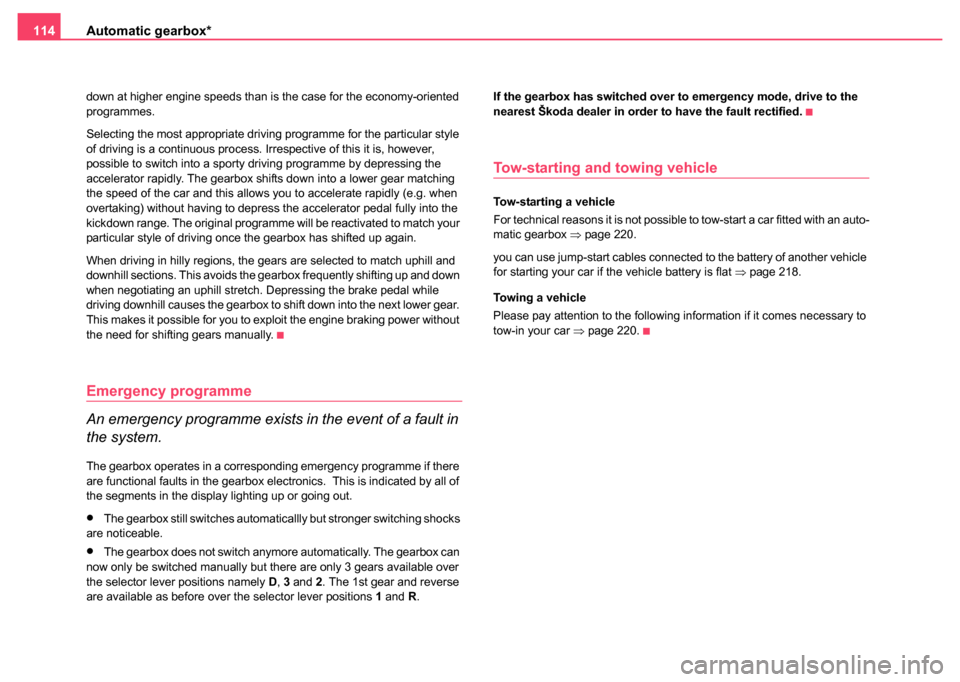
Automatic gearbox*
114
down at higher engine speeds than is the case for the economy-oriented
programmes.
Selecting the most appropriate driving programme for the particular style
of driving is a continuous process. Irrespective of this it is, however,
possible to switch into a sporty driving programme by depressing the
accelerator rapidly. The gearbox shifts down into a lower gear matching
the speed of the car and this allows you to accelerate rapidly (e.g. when
overtaking) without having to depress the accelerator pedal fully into the
kickdown range. The original programme will be reactivated to match your
particular style of driving once the gearbox has shifted up again.
When driving in hilly regions, the gears are selected to match uphill and
downhill sections. This avoids the gearbox frequently shifting up and down
when negotiating an uphill stretch. Depressing the brake pedal while
driving downhill causes the gearbox to shift down into the next lower gear.
This makes it possible for you to exploit the engine braking power without
the need for shifting gears manually.
Emergency programme
An emergency programme exists in the event of a fault in
the system.
The gearbox operates in a corresponding emergency programme if there
are functional faults in the gearbox electronics. This is indicated by all of
the segments in the display lighting up or going out.
•The gearbox still switches automaticallly but stronger switching shocks
are noticeable.
•The gearbox does not switch anymore automatically. The gearbox can
now only be switched manually but there are only 3 gears available over
the selector lever positions namely D, 3 and 2. The 1st gear and reverse
are available as before over the selector lever positions 1 and R. If the gearbox has switched over to emergency mode, drive to the
nearest Škoda dealer in order to have the fault rectified.
Tow-starting and towing vehicle
Tow-starting a vehicle
For technical reasons it is not possible to tow-start a car fitted with an auto-
matic gearbox
⇒page 220.
you can use jump-start cables connected to the battery of another vehicle
for starting your car if the vehicle battery is flat ⇒page 218.
Towing a vehicle
Please pay attention to the following information if it comes necessary to
tow-in your car ⇒page 220.
Page 137 of 247

Airbag system
136
Important safety information on the side airbag
Correct use of the airbag system considerably reduces the
risk of injury!
WARNING
•It is essential to always switch off ⇒page 137, “Deactivating an
airbag” the front passenger airbag when attaching a child safety
seat on the front passenger seat where the child is seated with its
back facing in direction of travel (in some countries also when the
child is facing the direction of travel). If this is not done, there is a
risk of the child suffering severe or even fatal injuries if the front
passenger airbag is deployed. In certain countries national legal
provisions also require that the side passenger airbags be deacti-
vated. When transporting a child on the front passenger seat,
please comply with the appropriate national regulations regarding
the use of child safety seats.
•Your head should never be positioned in the deployment area of
the side airbag. You might suffer severe injuries in the event of an
accident. This applies in particular to children who are transported
without using a suitable child safety seat ⇒page 143, “Child safety
and side airbags*”.
•If children adopt an incorrect seated position when travelling,
they may be exposed to an increase d risk of injury in the event of
an accident. This can result in serious injuries ⇒page 140, “Trans-
porting children safely”.
•There must not be any further persons, animals as well as
objects positioned between the occupants and the deployment
area of the airbag. There must also be no accessories such as cup
holders, attached to the doors to enable the side airbags to activate
properly.
•Only hang light items of clothing on the clothes hooks to the
vehicle. Never leave any heavy or sharp-edged objects in the
pockets of the items of clothing.
•Ensure that there are no excessive forces, such as violent
knocks, kicks etc., impact on the backrests of the seats otherwise
the system may be damaged. The side airbags would not be
deployed in such a case!
•Any seat or protective covers which you fit to the driver or front
passenger seats must only be of the type expressly authorized by
Škoda Auto. In view of the fact that the airbag inflates out of the
backrest of the seat, use of non-approved seat or protective covers
would considerably impair the protective function of the side
airbag.
•Any damage to the original seat covers in the area of the side
airbag module must be repaired without delay by your Škoda
dealer.
•The airbag modules in the front seats must not display any
damage, cracks or deep scratches. It is not permissible to use force
in order to open the modules.
•Any work on the side airbag system including removing and
installing system components beca use of other repair work (e.g.
removing seats) must only be carried out by a Škoda dealer.
WARNING (continued)
Page 241 of 247
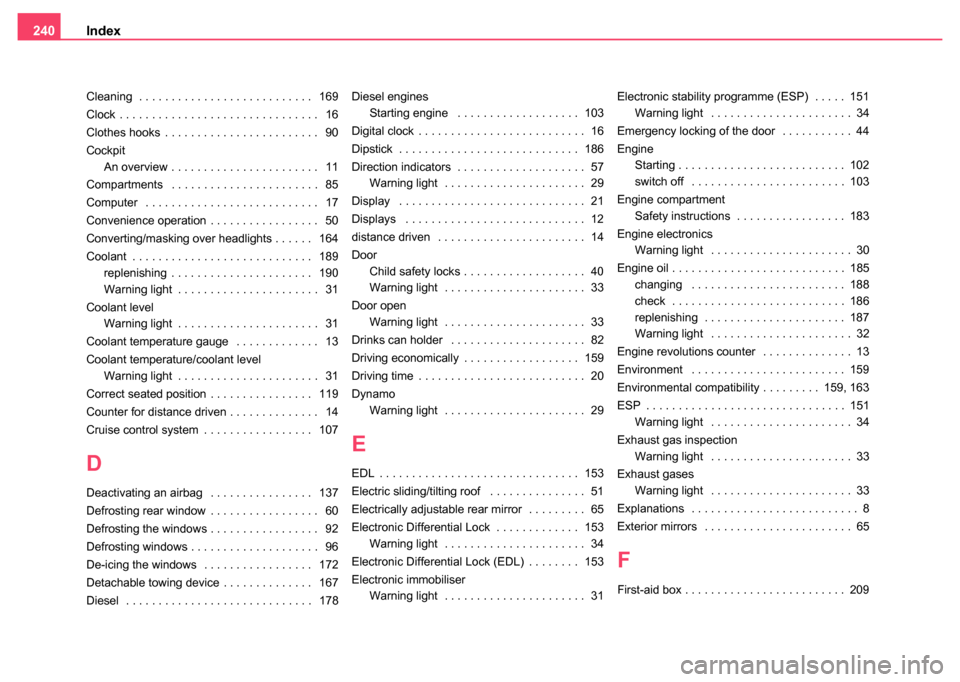
Index
240
Cleaning . . . . . . . . . . . . . . . . . . . . . . . . . . . 169
Clock . . . . . . . . . . . . . . . . . . . . . . . . . . . . . . . 16
Clothes hooks . . . . . . . . . . . . . . . . . . . . . . . . 90
Cockpit
An overview . . . . . . . . . . . . . . . . . . . . . . . 11
Compartments . . . . . . . . . . . . . . . . . . . . . . . 85
Computer . . . . . . . . . . . . . . . . . . . . . . . . . . . 17
Convenience operation . . . . . . . . . . . . . . . . . 50
Converting/masking over headlights . . . . . . 164
Coolant . . . . . . . . . . . . . . . . . . . . . . . . . . . . 189 replenishing . . . . . . . . . . . . . . . . . . . . . . 190
Warning light . . . . . . . . . . . . . . . . . . . . . . 31
Coolant level Warning light . . . . . . . . . . . . . . . . . . . . . . 31
Coolant temperature gauge . . . . . . . . . . . . . 13
Coolant temperature/coolant level Warning light . . . . . . . . . . . . . . . . . . . . . . 31
Correct seated position . . . . . . . . . . . . . . . . 119
Counter for distance driven . . . . . . . . . . . . . . 14
Cruise control system . . . . . . . . . . . . . . . . . 107
D
Deactivating an airbag . . . . . . . . . . . . . . . . 137
Defrosting rear window . . . . . . . . . . . . . . . . . 60
Defrosting the windows . . . . . . . . . . . . . . . . . 92
Defrosting windows . . . . . . . . . . . . . . . . . . . . 96
De-icing the windows . . . . . . . . . . . . . . . . . 172
Detachable towing device . . . . . . . . . . . . . . 167
Diesel . . . . . . . . . . . . . . . . . . . . . . . . . . . . . 178 Diesel engines
Starting engine . . . . . . . . . . . . . . . . . . . 103
Digital clock . . . . . . . . . . . . . . . . . . . . . . . . . . 16
Dipstick . . . . . . . . . . . . . . . . . . . . . . . . . . . . 186
Direction indicators . . . . . . . . . . . . . . . . . . . . 57 Warning light . . . . . . . . . . . . . . . . . . . . . . 29
Display . . . . . . . . . . . . . . . . . . . . . . . . . . . . . 21
Displays . . . . . . . . . . . . . . . . . . . . . . . . . . . . 12
distance driven . . . . . . . . . . . . . . . . . . . . . . . 14
Door Child safety locks . . . . . . . . . . . . . . . . . . . 40
Warning light . . . . . . . . . . . . . . . . . . . . . . 33
Door open Warning light . . . . . . . . . . . . . . . . . . . . . . 33
Drinks can holder . . . . . . . . . . . . . . . . . . . . . 82
Driving economically . . . . . . . . . . . . . . . . . . 159
Driving time . . . . . . . . . . . . . . . . . . . . . . . . . . 20
Dynamo Warning light . . . . . . . . . . . . . . . . . . . . . . 29
E
EDL . . . . . . . . . . . . . . . . . . . . . . . . . . . . . . . 153
Electric sliding/tilting roof . . . . . . . . . . . . . . . 51
Electrically adjustable rear mirror . . . . . . . . . 65
Electronic Differential Lock . . . . . . . . . . . . . 153Warning light . . . . . . . . . . . . . . . . . . . . . . 34
Electronic Differential Lock (EDL) . . . . . . . . 153
Electronic immobiliser Warning light . . . . . . . . . . . . . . . . . . . . . . 31 Electronic stability programme (ESP) . . . . . 151
Warning light . . . . . . . . . . . . . . . . . . . . . . 34
Emergency locking of the door . . . . . . . . . . . 44
Engine Starting . . . . . . . . . . . . . . . . . . . . . . . . . . 102
switch off . . . . . . . . . . . . . . . . . . . . . . . . 103
Engine compartment Safety instructions . . . . . . . . . . . . . . . . . 183
Engine electronics Warning light . . . . . . . . . . . . . . . . . . . . . . 30
Engine oil . . . . . . . . . . . . . . . . . . . . . . . . . . . 185 changing . . . . . . . . . . . . . . . . . . . . . . . . 188
check . . . . . . . . . . . . . . . . . . . . . . . . . . . 186
replenishing . . . . . . . . . . . . . . . . . . . . . . 187
Warning light . . . . . . . . . . . . . . . . . . . . . . 32
Engine revolutions counter . . . . . . . . . . . . . . 13
Environment . . . . . . . . . . . . . . . . . . . . . . . . 159
Environmental compatibility . . . . . . . . . 159, 163
ESP . . . . . . . . . . . . . . . . . . . . . . . . . . . . . . . 151 Warning light . . . . . . . . . . . . . . . . . . . . . . 34
Exhaust gas inspection Warning light . . . . . . . . . . . . . . . . . . . . . . 33
Exhaust gases Warning light . . . . . . . . . . . . . . . . . . . . . . 33
Explanations . . . . . . . . . . . . . . . . . . . . . . . . . . 8
Exterior mirrors . . . . . . . . . . . . . . . . . . . . . . . 65
F
First-aid box . . . . . . . . . . . . . . . . . . . . . . . . . 209
Page 242 of 247
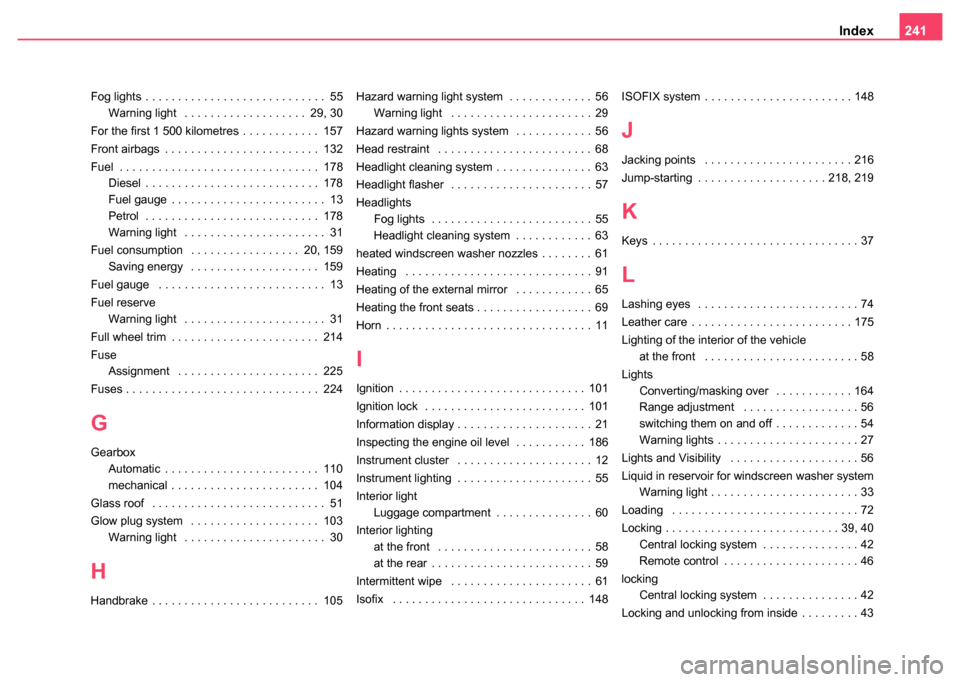
Index241
Fog lights . . . . . . . . . . . . . . . . . . . . . . . . . . . . 55
Warning light . . . . . . . . . . . . . . . . . . . 29, 30
For the first 1 500 kilometres . . . . . . . . . . . . 157
Front airbags . . . . . . . . . . . . . . . . . . . . . . . . 132
Fuel . . . . . . . . . . . . . . . . . . . . . . . . . . . . . . . 178 Diesel . . . . . . . . . . . . . . . . . . . . . . . . . . . 178
Fuel gauge . . . . . . . . . . . . . . . . . . . . . . . . 13
Petrol . . . . . . . . . . . . . . . . . . . . . . . . . . . 178
Warning light . . . . . . . . . . . . . . . . . . . . . . 31
Fuel consumption . . . . . . . . . . . . . . . . . 20, 159 Saving energy . . . . . . . . . . . . . . . . . . . . 159
Fuel gauge . . . . . . . . . . . . . . . . . . . . . . . . . . 13
Fuel reserve Warning light . . . . . . . . . . . . . . . . . . . . . . 31
Full wheel trim . . . . . . . . . . . . . . . . . . . . . . . 214
Fuse Assignment . . . . . . . . . . . . . . . . . . . . . . 225
Fuses . . . . . . . . . . . . . . . . . . . . . . . . . . . . . . 224
G
Gearbox Automatic . . . . . . . . . . . . . . . . . . . . . . . . 110
mechanical . . . . . . . . . . . . . . . . . . . . . . . 104
Glass roof . . . . . . . . . . . . . . . . . . . . . . . . . . . 51
Glow plug system . . . . . . . . . . . . . . . . . . . . 103 Warning light . . . . . . . . . . . . . . . . . . . . . . 30
H
Handbrake . . . . . . . . . . . . . . . . . . . . . . . . . . 105 Hazard warning light system . . . . . . . . . . . . . 56
Warning light . . . . . . . . . . . . . . . . . . . . . . 29
Hazard warning lights system . . . . . . . . . . . . 56
Head restraint . . . . . . . . . . . . . . . . . . . . . . . . 68
Headlight cleaning system . . . . . . . . . . . . . . . 63
Headlight flasher . . . . . . . . . . . . . . . . . . . . . . 57
Headlights Fog lights . . . . . . . . . . . . . . . . . . . . . . . . . 55
Headlight cleaning system . . . . . . . . . . . . 63
heated windscreen washer nozzles . . . . . . . . 61
Heating . . . . . . . . . . . . . . . . . . . . . . . . . . . . . 91
Heating of the external mirror . . . . . . . . . . . . 65
Heating the front seats . . . . . . . . . . . . . . . . . . 69
Horn . . . . . . . . . . . . . . . . . . . . . . . . . . . . . . . . 11
I
Ignition . . . . . . . . . . . . . . . . . . . . . . . . . . . . . 101
Ignition lock . . . . . . . . . . . . . . . . . . . . . . . . . 101
Information display . . . . . . . . . . . . . . . . . . . . . 21
Inspecting the engine oil level . . . . . . . . . . . 186
Instrument cluster . . . . . . . . . . . . . . . . . . . . . 12
Instrument lighting . . . . . . . . . . . . . . . . . . . . . 55
Interior light Luggage compartment . . . . . . . . . . . . . . . 60
Interior lighting at the front . . . . . . . . . . . . . . . . . . . . . . . . 58
at the rear . . . . . . . . . . . . . . . . . . . . . . . . . 59
Intermittent wipe . . . . . . . . . . . . . . . . . . . . . . 61
Isofix . . . . . . . . . . . . . . . . . . . . . . . . . . . . . . 148 ISOFIX system . . . . . . . . . . . . . . . . . . . . . . . 148
J
Jacking points . . . . . . . . . . . . . . . . . . . . . . . 216
Jump-starting . . . . . . . . . . . . . . . . . . . . 218, 219
K
Keys . . . . . . . . . . . . . . . . . . . . . . . . . . . . . . . . 37
L
Lashing eyes . . . . . . . . . . . . . . . . . . . . . . . . . 74
Leather care . . . . . . . . . . . . . . . . . . . . . . . . . 175
Lighting of the interior of the vehicle
at the front . . . . . . . . . . . . . . . . . . . . . . . . 58
Lights Converting/masking over . . . . . . . . . . . . 164
Range adjustment . . . . . . . . . . . . . . . . . . 56
switching them on and off . . . . . . . . . . . . . 54
Warning lights . . . . . . . . . . . . . . . . . . . . . . 27
Lights and Visibility . . . . . . . . . . . . . . . . . . . . 56
Liquid in reservoir for windscreen washer system Warning light . . . . . . . . . . . . . . . . . . . . . . . 33
Loading . . . . . . . . . . . . . . . . . . . . . . . . . . . . . 72
Locking . . . . . . . . . . . . . . . . . . . . . . . . . . . 39, 40 Central locking system . . . . . . . . . . . . . . . 42
Remote control . . . . . . . . . . . . . . . . . . . . . 46
locking Central locking system . . . . . . . . . . . . . . . 42
Locking and unlocking from inside . . . . . . . . . 43